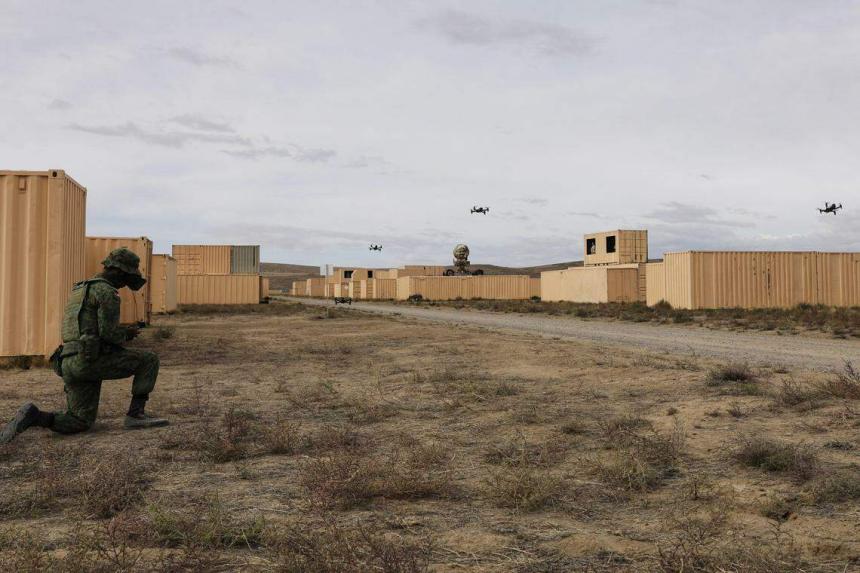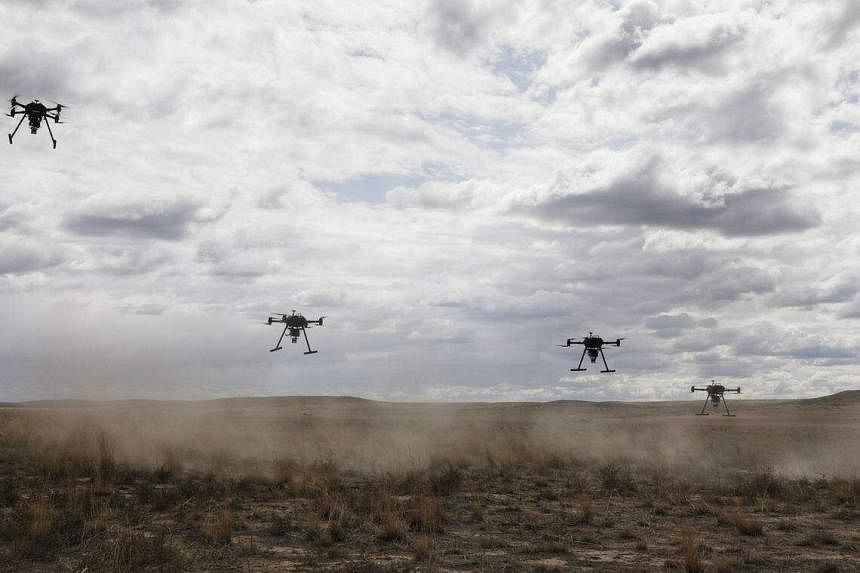MOUNTAIN HOME, Idaho – Amid the sand and rocks of the mountaintop, a series of footprints that seemingly belonged to a small animal dotted the landscape, walking towards unmarked containers simulating an urban environment.
From outside, the only thing that could be heard over the sound of the wind was the thuds emanating from within the containers – each step giving off a sense of foreboding.
When it finally emerged, the four-legged entity – the size of a German shepherd – was green, with a face resembling a spider as an array of sensors and cameras acted as its eyes.
The “spider dog” is actually an unmanned ground vehicle made by United States-based Ghost Robotics, with its capabilities developed by the Defence Science and Technology Agency (DSTA). The Singapore Army is currently trialling it as part of Exercise Forging Sabre in Idaho, to give soldiers an edge before they conduct urban operations.
Captain Loy Yong Wei, from the Singapore Armed Forces’ (SAF) Sense and Strike Accelerator Centre in Headquarters 6th Singapore Division, said the robot dogs are a “viable solution” for complex terrain and highly urbanised landscapes.
“They are able to do terrain confirmation as well as some target detection autonomously without us actually having boots on the ground,” said the 26-year-old lead officer for the project.
Through the use of light detection and ranging sensors, these robot dogs can create 3D models and maps of the terrain, which better inform soldiers of what to expect.
At the same time, the robot dog ensures the soldiers’ safety, said Mr Bryan Ng, 35, who heads the capability development of unmanned ground vehicles at DSTA.
“If it does detect a threat, then actually, its job is done. If it gets shot, it’s done its duty already... that’s why we use robots for this, not humans,” he said.
Adding to the army’s threat-detection capabilities is the use of micro UAVs (unmanned aerial vehicles), which was demonstrated by reconnaissance troops from the 11C4I battalion.
One soldier is able to operate multiple small drones via a tablet.
Through pre-planned flight routes, the drones are able to scan the battlefield, and have the captured footage processed via a computer through the use of algorithms to automatically identify targets, ranging from vehicles to weapon systems.
Members of the Singapore media were given a demonstration last Friday (Saturday Singapore time), where a single soldier – flanked by four others ready to take manual control of each drone if the need arose – activated four drones.

Footage captured by the micro UAVs was then streamed back to a screen out in the field, with targets marked by boxes, accompanied by an identifying label such as “tank”.
The benefits are twofold, said Major Alvinder Singh, 38, head of intelligence and operations development at the Army Intelligence Headquarters.
“With the reduction in manpower... in Singapore, we’ll be able to do more with a single person instead.
“The... systems are autonomous and smart enough to be able to pipe back (information) to a soldier, and that allows him to be able to assess the situation and gain better situational awareness,” he said.

While these unmanned platforms are used to aid troops on the ground, the Republic of Singapore Air Force (RSAF) is also testing its own set of drones, designed to provide feedback for the command post to facilitate its decision-making.
These drones are significantly larger – about the size of a lorry tyre – and instead of flying on pre-planned routes, they can autonomously scan the battlefield according to set parameters.
Captain Lim Ryan, 30, who is part of the RSAF’s drone swarm project, said the drones work in tandem with other RSAF UAVs which are flying at higher altitudes.
The swarm terminology used in relation to the drones does not refer to their quantity, but to the algorithm developed for them to operate autonomously.
“For example, if we give them a large area, they will segregate it, and they will go about their own searches within these areas,” he said.
Information is relayed to the command post, which can then decide the best course of action to take out the remaining threats.
Although the media was shown only four of the drones during a demonstration of their capabilities, there is potential for greater numbers of them to be used in the battlefield, said Capt Lim.
“(The algorithm) is scalable... whether we deploy it on one, four or 20 drones, they should act the same way.”


